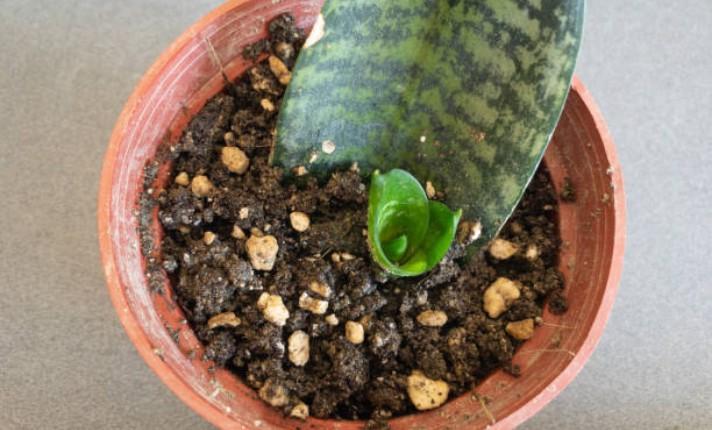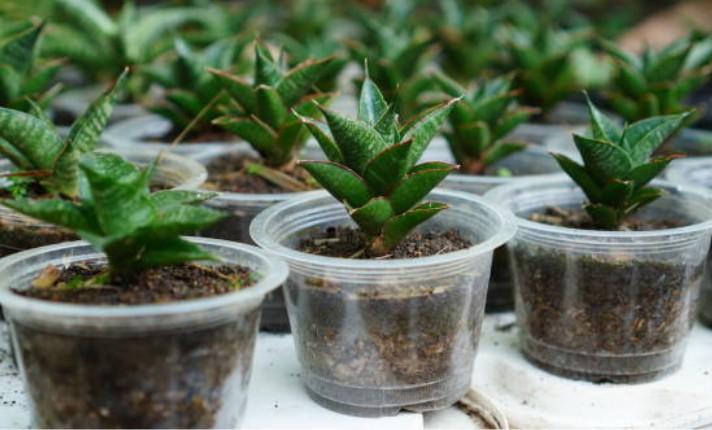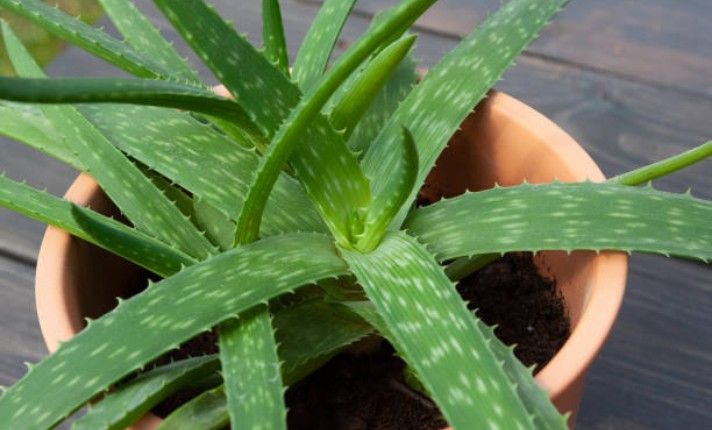Ever seen a snake plant and wondered how it grows? From a small seedling to a tall beauty, it’s fascinating to watch. Its thick, stiff leaves stand strong, even in tough conditions.
In the early stages, baby plants are small and simple. But give them some water and space, and they’ll quickly stretch upward. With low-maintenance care, they grow with ease.
As the plant matures, it produces more seedlings, filling the room with striking green and gold colors. Whether in your home or office, this plant can survive in almost any spot!
In this article, we’ll explore its growth stages, easy care tips, and the great benefits it brings to your home or office!
Table of Contents
ToggleOverview of Snake Plant Growth
The snake plant, or mother-in-law’s tongue, grows best in the right conditions. Its botanical name is Dracaena trifasciata, and it belongs to the Asparagaceae family.
These houseplants can live up to 20 years and are popular for their sword-shaped leaves. In good sunlight, they grow faster, but they grow slowly with less light. They need sandy, well-drained soil that is slightly acidic or alkaline.
They can reach a mature size of 2-5 feet. New growth appears from clumps of 10 to 20 leaves. Trim tall leaves to help them grow fuller. In the spring, they may bloom white flowers briefly.
Germination and Early Growth Stage
When growing a snake plant from seeds, it’s important to wait for the right moment. The germination time can take several weeks. Keep the seeds in a warm place and ensure they have enough moisture.
Once the seedlings begin to develop, make sure they get the correct light, temperature, and soil conditions. Snake plants need bright, indirect sunlight and prefer warm temperatures to grow well.
The soil should drain well to prevent overwatering. Early on, you might encounter common early growth challenges, such as not enough light or too much water, but with careful attention, the plant will start to grow steadily.

Seedling Development
In the first stage, snake plant seedlings begin unfurling their leaves slowly over a few weeks. They need light, humidity, and warmth to start photosynthesis, their main energy source.
However, without well-draining soil and proper watering, issues like root rot can appear. Overwatering or underwatering are both detrimental, so keeping the soil in drier conditions helps avoid problems.
As they grow, small changes, like temperature shifts or extreme heat, can significantly influence their pace. Keep an eye on spotting on the leaves, as it can hint at unhealthy conditions.
When managed well, the seedlings begin transforming into robust plants. With steady care, these plants will march towards the next stage, ready to handle drought-tolerant environments.

Vegetative Growth Phase
During the Vegetative Growth Phase, the Snake Plant enters a period of rapid expansion. This stage is marked by the growth of new leaves and an increasingly strong roots system.
The plant draws energy from sunlight and indirect light, which boosts its growth. Humidity levels and temperature also play a key role. A brighter environment can promote faster growth rates and even larger stems.
However, seasonal changes and environmental conditions can influence the plant’s overall health and stability. Proper care practices, like using a larger pot and maintaining the right water balance, can significantly enhance the plant’s development over several years.

Reproductive Cycle
The reproductive cycle of Snake Plants is both simple and amazing. It begins with the plant’s flowering stage and ends with seed production. Let’s look at each step.
- Flowering Stage
Snake Plants may surprise growers by entering their flowering stage when the plant becomes slightly stressed or pot-bound. A change in temperature often acts as a trigger, but it’s not a guaranteed method.
When the conditions are right, the plant displays a sign of maturity by blooming. This special event can last for several weeks, with the plant producing delicate, fragrant flowers.
- Seed Production
After pollination, the flowers develop into small, orange berries that contain seeds. The seeds take a few months to mature, marking the completion of the reproductive phase.
Once the seeds are ready, they can be used for propagation, allowing the plant to begin the cycle anew.
Snake Plant Care
Snake plants are low-maintenance houseplants, but they need care to prevent yellowing leaves and stunt growth. Knowing how to manage lighting requirements, watering schedules, and fertilizers will help your plant grow well and avoid common problems.
1. Light and Temperature
Did you know that too much direct sunlight can lead to brittle leaves? Place your snake plant in early-morning sunlight or natural light near windows, but make sure to protect it from cold drafts below 50°F to keep it thriving.
2. Watering and Soil
Overwatering is the fastest way to kill your plant. Let the top inch of soil dry out before watering, especially if using self-watering pots. A sandier soil or cactus soil works best to improve soil retention and prevent root rot.
3. Fertilizer and Seasonal Care
For healthy growth, use diluted liquid fertilizer or a 10-10-10 fertilizer at half strength every two weeks in spring and mid-summer. Follow the fertilizer package instructions, but avoid fertilizing during winter since the plant rests in colder months.
Repotting and Pruning for Continuous Growth
Snake plants need regular care to avoid stunted growth and maintain healthy roots. One key part of this care is pruning and repotting to ensure they continue to grow strong.
- Pruning to Encourage New Growth
Pruning your snake plant helps remove damaged leaves and clear up space for new growth. Using a sterile cutting tool, trim away any dull or damaged leaves during the growing season, especially in spring.
This not only improves the plant’s appearance but also keeps it from getting overcrowded. Regular pruning reduces stress on the plant, encouraging it to produce offshoots and stay healthy.
- Pot Size for Repotting
Choosing the right pot size is essential to prevent overcrowded roots and cracks in the pot. A slightly larger pot allows the root ball to spread and grow without restricting the plant’s growth.
Avoid going too large, as this can hold too much moisture, which may lead to overwatering.
- Type of Pot
The material of the pot plays an important role in keeping your snake plant healthy. Terracotta and ceramic pots provide good air circulation but are prone to cracks over time.
Plastic pots hold moisture longer, which can be helpful, but make sure they have good water draining holes to avoid root rot.
- When to Repot
Repot your snake plant in the spring every 2-3 years or when you notice overcrowded roots or slow growth. This is the best time to give the plant a fresh start with new soil and a new container, ensuring it has room to grow.
Troubleshooting Common Problems
When snake plants face challenges, signs like curled tips, wrinkled leaves, or black tips may appear. Quick action ensures healthy growth.
Watch for pests, fungal infections, or issues caused by overwatering and poor potting material. Below is a handy guide to address these common problems efficiently.
| Problem | Cause | Solution |
| Curled Tips | Cold damage or insufficient light | Move to a bright location and reduce watering. |
| Mushy Roots | Overwatering conditions | Let the plant dry out and inspect for rot. |
| Visible Pests | Pest development | Apply neem oil spray or wash with mild soap. |
| Yellow Leaves | Too much fertilizer | Use water for flushing fertilizer buildup. |
| Brown Leaf Edges | Excessive sunlight or pest irritation | Limit direct sunlight and treat pests if present. |
| Drooping Leaves | Poor potting material | Repot with mixed ingredients and fresh soil. |
| Blackened Leaves | High temperatures | Rotate plant and maintain soaking moisture. |
| Toxic to Pets | Toxic nature of the plant | Keep it out of reach from animals. |
Benefits of Snake Plants
Snake plants are perfect for both new and experienced gardeners. They fit well in small spaces due to their compact size, and they thrive in various conditions like low-light or even drought.
As they grow, their unique shape and height add interest to any green spaces. These plants are practical for busy plant owners because they are resistant to most pests and diseases, making them almost indestructible.
Here’s a table summarizing the key benefits of owning a snake plant.
| Benefit | Details |
| Easy care | Tolerates low-light, drought, and various conditions. |
| Compact and adaptable | Starts small, fits well in small spaces, grows to good height. |
| Air purification | Improves air quality, making it a great choice for indoor spaces. |
| Resistant and durable | Almost indestructible, handles different environments easily. |
| Low maintenance | Requires minimal care, perfect for busy or first-time gardeners. |
FAQ’s
Q: How Quickly Does a Snake Plant Grow?
A: A snake plant is slow-growing and takes several years to grow fully. It grows faster in bright light but stays healthy in low light. If it becomes root-bound after three to five years, it should be repotted to prevent crowded roots from slowing growth.
Q: What Is the Best Fertilizer for Snake Plants?
A: Use liquid fertilizer with a 10-10-10 NPK ratio during the growing season. Apply it once or twice monthly in summer.
Always dilute to the recommended strength and mix in a bottle with spring water. Fertilize only after watering to protect roots.
Q: Where Not to Put Snake Plant?
A: Avoid direct sunlight; it can burn the leaves. Don’t place it outside in scorching heat. Choose a spot with indirect light for best growth.
Q: How Long Do Snake Plants Live?
A: Snake plants can live for many decades with proper care. In winter, they might feel dry and only need water every two months. They last a long time once you know how to care for them. In spring, check the soil; if it’s dry, give them a little water.
Conclusion
Knowing the different phases of your snake plant’s development allows you to provide the best care for optimal growth. From sprouting seeds to potential blooms, each phase needs specific light and water.
Adjust your routine as the plant develops to support steady growth. With basic care, your snake plant can flourish, showcasing its sturdy leaves and possibly blooming when conditions are ideal. Ready to grow yours? Start today and enjoy every stage!

